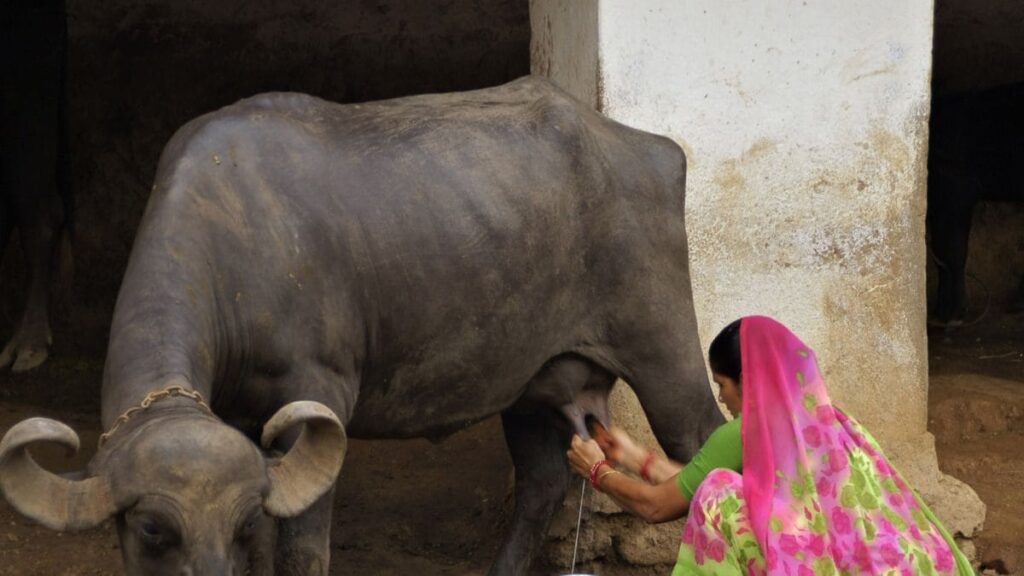
The issue of A1 and A2 milk gained prominence recently after the Food Safety and Standards Authority of India (FSSAI) banned the use of “misleading” tags by companies. Several experts and nutritionists have called out the “dairy drama”, and benefits of cow and buffalo milk available in the country.
The FSSAI had in August issued a directive to companies selling dairy products such as milk, ghee, butter and curd in the name of A1 and A2 under the FSSAI licence number.
It said the distinction between A1 and A2 milk is based on the structure of protein called beta-casein, which can confuse consumers.
It has also in May advised that all activities related to the commercialisation of human milk and its products should be stopped. It added that the FSSAI “has not permitted the processing and / or selling of human milk under FSS Act, 2006 and rules/regulations made there under.”
Let us look at some data on India’s position as the world’s largest producer of milk, the types of milk available in the country, the dairy dilemma and expert view.
India’s Dairy Drive
The country contributes 25% of the global milk production. It has seen a 58% increase in milk production in the last nine years at 230 million tonnes in 2022-23.
The top five milk-producing states are Rajasthan (15.05%), Uttar Pradesh (14.93%), Madhya Pradesh (8.6%), Gujarat (7.56%) and Andhra Pradesh (6.97%). They together contribute 53.11% of total milk production in the country.
India exported around 63,738 million tonnes of dairy products to the world worth $272.64 million in 2023-24.
Dairy is the single largest agricultural commodity contributing 5% of the national economy, witnessing 6.4% CAGR (Compound Annual Growth Rate) in the past five years. Market for butter and spreads is predicted to grow at an 8% CAGR to $4.2 billion by 2026.
Finance minister Nirmala Sitharaman in her Budget speech in July stressed the government’s effort to support dairy farmers and said a major effort is being made to control the foot and the mouth disease.
What are the types of milk available in India?
Most of the milk produced in India comes from animals such as cows, buffaloes and goats. As per a paper by Dr Narendra K Nayak, Department of Livestock Products Technology, College of Veterinary Science & A.H., Mhow, the PFA standards for different classes and designations of milk in India are categories into raw, pasteurized, boiled, flavoured and sterlised for all states and Union Territories.
Buffalo milk is available in almost state and UT in India, containing milk fat at 6% and milk solids-not-fat (SNF) at 9%. The SNF largely consists of proteins, lactose and minerals. The average composition of buffalo milk comprises 82.76% water, fat 7.38%, protein 3.60% and lactose 5.48%. Both buffalo and cow milk fats consist chiefly of the triglycerides of fatty acids, which make up 95-99 per cent of milk fat. Cholesterol is lowest for buffalo (235-248 mg/100 g fat) compared to the western breeds of cattle. As compared to cow milk, buffalo milk is richer in total proteins, particularly the casein and whey proteins.
Cow milk has ‘total solids’ at 12%, with milk fat comprising 4% in Chandigarh, Haryana and Punjab, while for other states the milk fat is at 3.5%. In most cow milk, available commercially, water content is above 86% while protein is above 3%. In cow milk, the cholesterol level is higher than in buffalo at 303-385mg/100g fat. Buffalo casein has superior whitening as compared to that of cow casein due perhaps to a higher proportion of calcium present in it. Cow milk has low amounts of lactose in the range of 4.5-4.8%.
Goat milk has 87% of water content while fat, protein and lactose compositions are 4.25%, 3.52% and 4.27%. A survey by the Gujarat animal husbandry directorate estimated the state’s goat population at 50.55 lakh in 2021-22, and the goat milk production at 3.39 lakh tonnes (329 lakh litres; 1 litre is equal to 1.03 kg of milk). This was around 2% of the state’s total milk production. Doctors say goat milk is prescribed to neonates if the mother is not able to breastfeed. Also, the lactose intolerant people can consume goat milk without much difficulty.
Camel milk is 5% of the 295 lakh litres of milk per day procured by the Gujarat State Co-operative Milk Marketing Federation (GCMMF) from camel breeders in Kutch district five years ago. According to Naran Rabari, the president of the Surendranagar Jilla Gheta-Bakra Uchherak Maldhari Sangathan (Surendranagar District Sheep-Goat Rearers’ Maldhari Union), the pastoralists’ organisation that is pushing for the separate collection and marketing of goat milk, Amul started procuring camel milk through Sarhad Dairy of Kutch in 2018, mentioned in a report by The Indian Express. Unlike camels, whose population fell from 40 lakh in 2012 to just 2.5 lakh in 2019, the goat population rose from 13.51 crore to 14.88 crore during this period.
What are A1 and A2 milk?
According to FSSAI, the distinction between A1 and A2 milk is based on the structure of beta-casein protein in milk, which varies depending on the breed of the cow.
According to Healthline, some studies suggest that A2 may be healthier, but research is ongoing. Some studies suggest that A1 beta-casein may be harmful and that A2 beta-casein is a safer choice.
Casein is the largest group of proteins in milk, making up about 80% of total protein content.
A1 beta-casein: Milk from breeds of cows that originated in northern Europe is generally high in A1 beta-casein. These breeds include Holstein, Friesian, Ayrshire, and British Shorthorn.
A2 beta-casein: Milk that is high in A2 beta-casein is mainly found in breeds that originated in the Channel Islands and southern France. These include Guernsey, Jersey, Charolais, and Limousin cows.
Some studies suggest when A1 beta-casein is digested, it may produce a peptide called beta-casomorphin-7 (BCM-7), which has been linked to various health issues like inflammation, digestive discomfort, and even a higher risk of heart disease and diabetes.
Experts on A1 and A2 Issue
The controversy over A1 and A2 milk types gained prominence after a New Zealand-based scientist and entrepreneur, who founded A2 Corporation (later rebranded as The A2 Milk Company), claimed in 2000 that more A1 protein in milk over A2 could lead to type 1 diabetes, autism, cardiovascular disease and digestive issues.
McLachlan petitioned Food Standards Australia New Zealand in 2003 to print health warnings on the packages of A1 milk. Not only was this rejected, but A2 Corporation was also asked to even withdraw claims on A2 milk.
The European Food Safety Authority declared in 2009 that no cause and effect relationship could be established between BCM-7 released by dietary intake of A1 milk and various diseases. However, A2 milk continued to sell at a premium price in markets in India and across worlds.
Around 50-65% of (Holstein-Friesian) cows in North America produce A1 milk. But over 90% cows of the same breed in Germany produce A2 milk.
Amul managing director Rupinder Singh Sodhi had in an interview to ThePrint two years ago dismissed reports that Indian milk comprises the less healthy A1 protein. He had said that in India, people consume buffalo and indigenous cow milk, which is “100% A2 milk”.
ThePrint report quoting Ranvir Singh, principal scientist, division of animal genetics, Indian Veterinary Research Institute (IVRI), said, “A1 milk produced by foreign cows doesn’t have as much nutritional value in iron and taste as compared to A2 milk produced by our desi cows.”
How Should Consumers Choose Milk Products?
Consider buying A2 milk from cows that eat grass and natural fodder. Grass-fed cattle can provide you with the greatest milk.
Look for milk that contains no added hormones and is not injected with harmful antibiotics.
Instead of getting caught up in marketing claims of A1 and A2 products, it’s more important to evaluate the overall quality of milk based on fat content, calcium levels, the presence of added vitamins like D and B12, and the overall freshness of the product.
What are the Milk Substitutes Available in Market?
Coconut milk: It is made from the flesh of coconuts. It has a rich and creamy texture with a distinct coconut flavour.
Oat milk: It is made from whole oat grains or oatmeal blended with water. It has a mild, slightly sweet taste and a creamy texture.
Rice milk: It is made from milled rice and water. It tends to be thinner than cow’s milk and has a sweeter taste.
Nut milk: You can pretty much conjure milk out of any nut available in the market – almonds, peanuts, hazelnuts, cashews and Macadamia. Nut milk is low in calories and can be fortified with essential nutrients such as calcium, vitamin D, and vitamin B12, making them nutritionally comparable to cow’s milk.
Soy milk: Made from soybeans, soy milk is a popular dairy alternative. It is often fortified with vitamins and minerals to match the nutritional content of cow’s milk.




